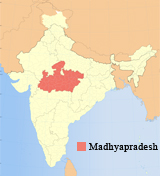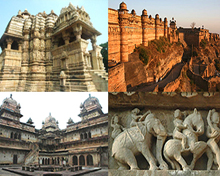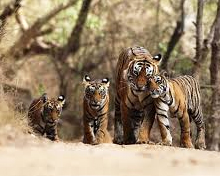Madhya Pradesh
 Madhya Pradesh is located in the central part of India. It is spread across 443,450sq km. In this state, there are numerous hills, plateaus, plains, rivers, forest. Madhya Pradesh can be divided into six parts. These are the Northern Plains, the Hilly Region of the Vindhyas, the Narmada Valley, the Malwa Plateau, the Plains of Chhattisgarh, the mountainous region of Bastar.
Madhya Pradesh is located in the central part of India. It is spread across 443,450sq km. In this state, there are numerous hills, plateaus, plains, rivers, forest. Madhya Pradesh can be divided into six parts. These are the Northern Plains, the Hilly Region of the Vindhyas, the Narmada Valley, the Malwa Plateau, the Plains of Chhattisgarh, the mountainous region of Bastar.
Madhya Pradesh is regarded as a hub of the historical cross currents from the North, South, East and the West, which can be attributed to its strategic positioning. The Bhimbetka Caves in Madhya Pradesh that house some paintings that can be traced back to the Paleolithic age. These caves served as the abode of the early human beings. Madhya Pradesh has a rich and exciting history. Madhya Pradesh flourished under the Gupta rule and was subsequently incorporated within the empire carved out by Harshavardhana.
With the subsequent ebbing of the imperial power, Madhya Pradesh became disorganized and was widespread with unimportant squabbles and battles between small principalities contending for ascendancy. The history of Madhya Pradesh is noticeable by a short spell of constructive activity under the Chandels during the 10th and the 11th centuries. Another milestone in the Madhya Pradesh history is the series of the Chandels by the Pratihara and the Gaharwar Rajput dynasties.
They set high standards for themselves as far as the code of chivalry was concerned and squandered away their paltry resources on a luxurious feudal lifestyle. The influential Muslim power broke through the last bastion of resistance to take control.
A majority of the smaller kingdoms in Madhya Pradesh were actually the lands donated as gifts by the Emperor at Delhi to those who had provided valuable services. The climate of Madhya Pradesh is normal. The temperature starts rising in Madhya Pradesh from March onwards but it differs from region to region. In summer, maximum temperature goes up to around 42.5oC in northern MP at places like Gwalior.
It is 40o-42.5oC in places like Bhopal, Sagar, Rewa, Bilaspur and Raigarh, to name a few. In other places, it ranges from 35o-400C. The monsoon begins in end-June/July and last till end-August. The temperature remains more or less the same till September-October. Temperature drops in the arrival of winter. Winter reaches its peak in the month of December in some places, and in January, in others.
 The Monuments in Madhya Pradesh are the major source of historical facts and also attract tourists to Madhya Pradesh. These Monuments in Madhya Pradesh, India have been established in various ages dating as early as the first century A.D. Several Dynasties contributed to these monuments including forts, palaces, temples (of Hindus and Jains), mosques, tombs, churches, stupas, tanks, reservoirs, and caves cut out of rocks.
The Monuments in Madhya Pradesh are the major source of historical facts and also attract tourists to Madhya Pradesh. These Monuments in Madhya Pradesh, India have been established in various ages dating as early as the first century A.D. Several Dynasties contributed to these monuments including forts, palaces, temples (of Hindus and Jains), mosques, tombs, churches, stupas, tanks, reservoirs, and caves cut out of rocks.
These monuments in Madhya Pradesh are maintained by various governmental as well as non governmental bodies like Directorate of Archaeology, Archives and Museums, and Archeological Survey of India. Approximately, 335 Monuments in Madhya Pradesh are preserved by the Department of Archaeology of the State Government of Madhya Pradesh while the Archaeological Survey of India is maintaining about 282 of them.
The lakes and gardens in Madhya Pradesh are tempting. The rugged terrain of Madhya Pradesh cut across by the waters of the Narmada and populated by deciduous vegetation supports a large number of lakes and waterfalls, increasing the scenic beauty of the place. The lakes and gardens in Madhya Pradesh in India are a combination of controlled wilderness and landscape architecture. These are widely visited by tourists on a tour to Madhya Pradesh.
Madhya Pradesh is well connected to the other cities in India. A good network of railways and road connects all parts of Madhya Pradesh flawlessly. The Khajoraho temples, the marble rock at Jabalpur, the Bandhavgarh, Kanha and Panna National Parks, Manu, Panchmarhi are some of the most visited places in Madhya Pradesh. Wildlife in Madhya Pradesh is also a major attraction for the tourists.
 Kanha National Park is famous Wildlife park in Madhya Pradesh. Kanha's rolling grasslands, sal and bamboo forests and meandering streams offer a dramatic natural splendor for the visitors. Bandhavgarh National Park is another leading name in Wildlife. Bandhavgarh in Madhya Pradesh is identified for its highest density of tiger population within India. Tourists can also see a large range of natives birds and animals at this place.
Kanha National Park is famous Wildlife park in Madhya Pradesh. Kanha's rolling grasslands, sal and bamboo forests and meandering streams offer a dramatic natural splendor for the visitors. Bandhavgarh National Park is another leading name in Wildlife. Bandhavgarh in Madhya Pradesh is identified for its highest density of tiger population within India. Tourists can also see a large range of natives birds and animals at this place.
In Wildlife in Madhya Pradesh, Panna National Park is also well-known The Ken River passing through this park adds to its charming beauty. The predominant species like Chinkara, the Chital and the Indian gazelle are found. Other species found here include Sambar, Nilgai, Blackbuck, Sloth Bear, Chausingha or four-horned Antelope, Leopard, striped Hyaena, common Langur, Tiger, Jackal, Wild Boar, Jungle Cat, Crocodile and others.
Holy Places in Madhya Pradesh are not merely the edifies built up of stone, but they are the reminders of the rich cultural past of this state. They are at the same time also suggestive of the religious harmony among the different sects. Ujjain is primarily known for the magnificent temples devoted to the various Hindu deities and Bhopal houses several impressive mosques. These holy places also have sprawling lawns and gardens that are well maintained.